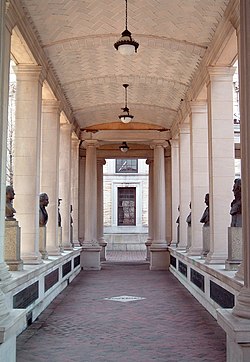
Back Hall of Fame for Great Americans Catalan Hall of Fame for Great Americans German Salón de la Fama para Americanos Ilustres Spanish Hall of Fame for Great Americans French היכל התהילה לאמריקאים הגדולים HE Հայտնի ամերիկացիների փառքի սրահ Armenian Hall of Fame for Great Americans Italian Зал славы великих американцев Russian 美国伟人名人堂 Chinese
Hall of Fame Complex | |
New York City Landmark No. 0113
| |
 View of the Hall of Fame for Great Americans | |
 | |
| Location | Bronx Community College campus, The Bronx, New York |
|---|---|
| Coordinates | 40°51′31.7″N 73°54′50.9″W / 40.858806°N 73.914139°W |
| Area | 2 acres (0.81 ha) |
| Built | 1901 |
| Architect | Stanford White |
| Architectural style | Classical Revival, Beaux-Arts |
| NRHP reference No. | 79001567[1] |
| NYCL No. | 0113 |
| Significant dates | |
| Added to NRHP | September 7, 1979 |
| Designated NYCL | February 15, 1966 |
The Hall of Fame for Great Americans is an outdoor sculpture gallery located on the grounds of Bronx Community College (BCC) in the Bronx, New York City. It was the first such hall of fame in the United States. Built in 1901 as part of the University Heights campus of New York University (NYU), the structure was designed by architect Stanford White to conceal a retaining wall for the Gould Memorial Library. The hall commemorates 102 prominent Americans, selected by a board of electors and grouped into one of fifteen categories. The physical structure consists of a loggia with colonnades measuring 630 feet (190 m) long. The colonnades contain niches with plaques and 96 bronze portrait busts.
The philanthropist Helen Gould donated funds for the structure in 1900, and the Hall of Fame was formally dedicated on May 30, 1901. Soon after the Hall of Fame opened, it became a focal point for U.S. national pride. Originally, the hall only contained plaques honoring native-born U.S. citizens. The first bust was installed in 1907, and foreign-born citizens were inducted starting in 1915. The majority of the busts were sculpted between 1922 and 1930. Most of the busts dedicated between 1930 and 1970 were installed shortly after the elections of their respective honorees.
The Hall of Fame became part of BCC after NYU sold its Bronx campus to the City University of New York in 1973. The last honorees were elected in 1976, and the Hall of Fame has largely fallen into obscurity since then. The busts of Louis Brandeis, Clara Barton, Luther Burbank, and Andrew Carnegie were never sculpted due to a lack of funding, while the remaining 98 busts started to decay over the years. Following periods of deterioration, BCC renovated the Hall of Fame several times in the late 20th and early 21st centuries. BCC removed the busts of Confederate generals Robert E. Lee and Stonewall Jackson in 2017 following a white supremacist rally in Charlottesville, Virginia, that led to national outcry against Confederate monuments more broadly.